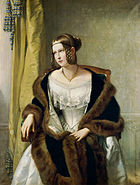Philipp Veit
This article needs additional citations for verification. (July 2014) |
show This article may be expanded with text translated from the corresponding article in German. (May 2010) Click [show] for important translation instructions. |


Philipp Veit (13 February 1793 – 18 December 1877) was a German Romantic painter. It is to Veit that the credit of having been the first to revive the nearly forgotten technique of fresco painting is due.[1]
Biography[]
Veit was born in Berlin, Prussia. He was the son of a banker, Simon Veit and his wife Brendel, daughter of Moses Mendelssohn, who subsequently left him to marry Friedrich Schlegel. Veit received his first art education in Dresden, where he was taught by Caspar David Friedrich,[2] and Vienna. Although a prodigious talent when it came to drawing, Veit was not comfortable with oil painting, for which reason in Vienna he took to the medium of watercolour. In Vienna, he made the acquaintance of Schlegel, and through him came to know several Viennese Romantics, one of whom was the poet and novelist Joseph von Eichendorff.[2] He was strongly influenced by, and joined, the Nazarene movement in Rome, where he worked for some years before moving to Frankfurt.[1]
Veit participated in the struggle against Napoleon in 1813–14, returning to Berlin for a short period. In 1815, he finished the Virgin with Christ and St John, a votive painting for the church of St James in Heiligenstadt, Vienna. The painting was inspired by the style of Pietro Perugino and Raphael.[2]
In Frankfurt, where his most important works are preserved at the Städel, he was active from 1830 to 1843 as director of the art collections and as professor of painting. From 1853 till his death in 1877 he held the post of director of the municipal gallery in Mainz. Like his fellow Nazarenes he was more draughtsman than painter, and though his sense of colour was stronger than that of Overbeck or Cornelius, his works are generally more of the nature of coloured cartoons than of paintings in the modern sense.[1]
Veit's principal work is the large fresco of The Introduction of Christianity into Germany by St Boniface, at the Städel. In the Frankfurt Cathedral is his Assumption, while the Alte Nationalgalerie of Berlin has his painting of The Two Marys at the Sepulchre.[1] An example of his romantic work is Germania, a national personification of Germany, located in the Städelsches Kunstinstitut.
Veit died in Mainz.
Paintings by Philipp Veit[]

Detail from a fresco at
the Villa Massimo
"Allegory of Russia"

Marie Freifrau von Bernus.
"Allegory of Religion"

Maria von Mörl, Mystic, Stigmatic, Victim for Sinners Painted by Philipp Veit
| Wikimedia Commons has media related to Philipp Veit. |
References[]
- ^ Jump up to: a b c d One or more of the preceding sentences incorporates text from a publication now in the public domain: Chisholm, Hugh, ed. (1911). "Veit, Philipp". Encyclopædia Britannica. 27 (11th ed.). Cambridge University Press. p. 973.
- ^ Jump up to: a b c "Philipp Veit". Oxford Grove Art. Retrieved 11 March 2013.
- 19th-century German painters
- 19th-century male artists
- German male painters
- Jewish painters
- 18th-century German Jews
- Artists from Berlin
- Mendelssohn family
- 1793 births
- 1877 deaths
- Nazarene painters
- German painter stubs




